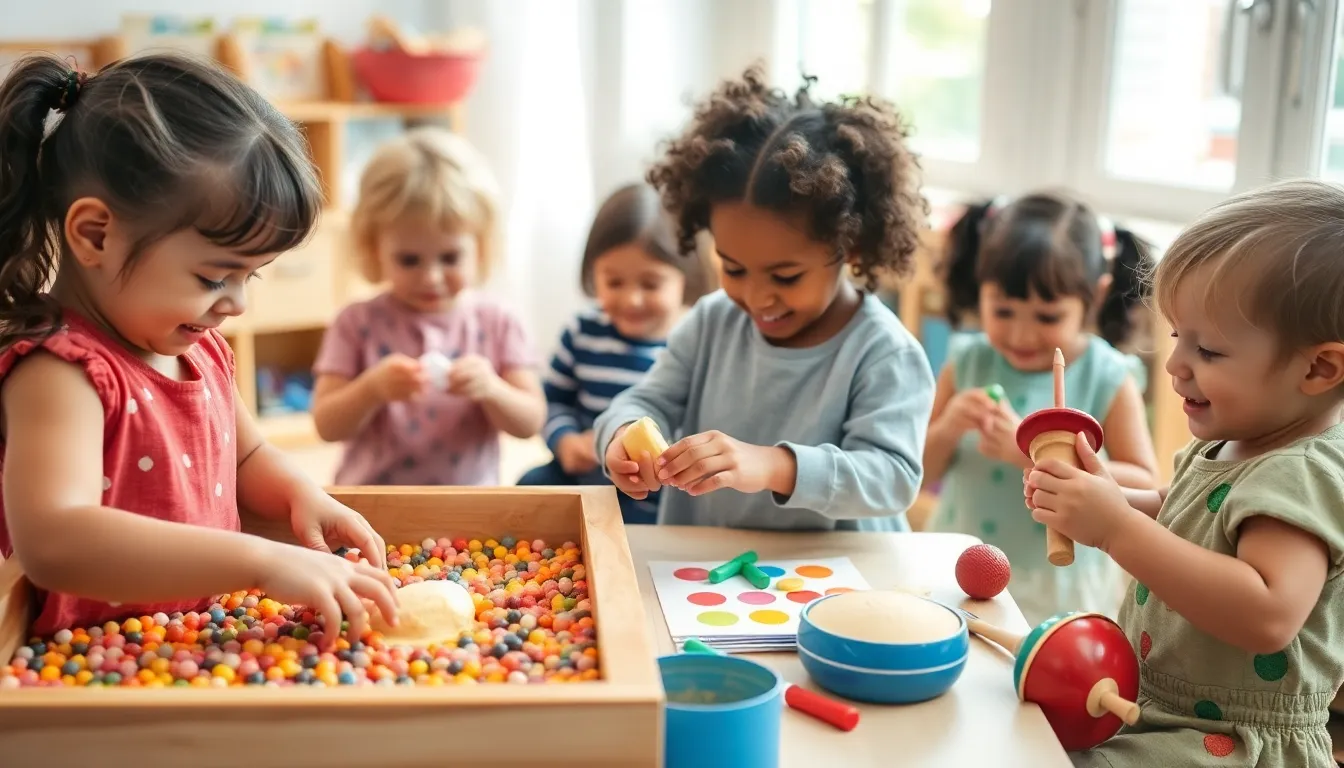In a world where kids are glued to screens, Montessori sensory play offers a refreshing escape into hands-on exploration. It’s not just about keeping little hands busy; it’s a thrilling adventure that sparks curiosity and creativity. Imagine a child diving into a world of textures, sounds, and colors, all while developing essential skills—talk about multitasking!
Montessori sensory play encourages children to engage with their environment in a way that’s both fun and educational. From squishy slime to crunchy leaves, each activity is designed to ignite their senses and foster independence. Who knew that playing with pasta could lead to fine motor skills? So, let’s dive into the wonderful world of Montessori sensory play and discover how it can transform everyday moments into magical learning experiences.
Table of Contents
ToggleUnderstanding Montessori Sensory Play
Montessori sensory play centers on a child’s innate desire to explore the world through their senses. This method emphasizes experiential learning, allowing children to discover and interact with various materials, fostering both cognitive and physical development.
The Philosophy Behind Montessori
Montessori education prioritizes self-directed, hands-on learning. Children learn at their own pace while engaging with materials that spark their interest. This approach values independence, allowing kids to make choices and explore their environments freely. Respect for each child’s unique development is a core principle, making it essential to provide learning experiences tailored to individual needs.
Importance of Sensory Experiences
Sensory experiences underpin children’s learning and development in profound ways. Engaging with different textures, sounds, and colors enhances cognitive skills and fine motor abilities. Activities that stimulate the senses cultivate curiosity, critical thinking, and creativity. By interacting with sensory-rich environments, children not only enjoy play but also build essential life skills, preparing them for future challenges.
Types of Montessori Sensory Play Activities

Montessori sensory play includes a variety of activities designed to engage children’s senses. Different types of activities promote unique skill development.
Tactile Activities
Tactile activities offer children opportunities to explore textures. Playing with materials like sand, rice, or fabric can stimulate their sense of touch. Activities such as creating a sensory bin filled with dried beans or using play dough enhance fine motor skills. Making slime also allows for exploration of different textures while children enjoy the creative process. Combining various materials provides a rich sensory experience, encouraging experimentation and discovery.
Visual Activities
Visual activities stimulate children’s sight and promote visual tracking. Color sorting with colorful blocks or pom-poms fosters recognition and categorization. Engaging in activities like painting or using light tables encourages creativity and imagination. Crafting with colored paper helps develop coordination and spatial awareness. Through these activities, children learn to differentiate colors and shapes, enhancing their visual perception skills.
Auditory Activities
Auditory activities focus on developing children’s listening skills. Instruments like tambourines, maracas, or xylophones introduce different sounds and rhythms. Singing songs or engaging in sound matching games heightens awareness of auditory cues. Playing sound lotto, where children match sounds to images, sharpens their listening abilities. These activities nurture a sense of rhythm and improve their ability to differentiate between various sounds.
Benefits of Montessori Sensory Play
Montessori sensory play provides numerous advantages for children’s learning and development. Engaging with tactile materials and diverse activities enhances growth in various areas.
Developmental Benefits
Sensory play supports fine and gross motor skill development. Children practicing grasping, squeezing, or pouring enhance dexterity and coordination. Cognitive skills also flourish through sensory exploration, as kids learn to categorize and manipulate different materials. Problem-solving abilities improve when children experiment with textures or shapes. Moreover, sensory experiences stimulate the brain and foster neural connections, aiding overall cognitive development.
Emotional and Social Skills
Emotional intelligence strengthens through shared sensory play experiences. Playing in groups encourages communication and collaboration, teaching children how to negotiate and share resources. Expressing feelings becomes easier as children interact with others, leading to increased empathy. When kids face challenges during sensory activities, they gain resilience and confidence. Furthermore, engaging in these experiences allows children to regulate their emotions better, creating a more harmonious social environment.
Implementing Montessori Sensory Play at Home
Creating a sensory-rich environment at home encourages children’s exploration and learning. It allows them to engage with various textures, sounds, and colors in innovative ways.
Setting Up a Sensory Space
Designate a specific area for sensory activities to minimize distractions. Use sturdy bins or tables to contain materials and provide children with ample space to explore. Brightly colored rugs or mats can define this space and invite creativity. Ensure materials are easily accessible, fostering independence. Safety is crucial, so use age-appropriate items and supervise while children engage in activities.
Suggested Materials and Activities
Gather a variety of materials for sensory play, including water, sand, rice, or pasta. Explore tactile activities like making play dough or creating sensory bins filled with different textures. Incorporate visual elements with activities like color sorting using various small items or engaging in painting with vibrant colors. Introduce auditory experiences through sound matching games or simple instruments like shakers and drums. These activities enhance fine motor skills while providing multi-sensory engagement.
Montessori sensory play offers a dynamic way for children to engage with their environment and develop crucial skills. By immersing themselves in tactile, visual, and auditory experiences, children not only learn through exploration but also cultivate their creativity and problem-solving abilities.
Creating a sensory-rich environment at home can enhance this learning journey, allowing kids to thrive in a space designed for discovery. As they interact with various materials and activities, they build independence and confidence, setting the stage for lifelong learning. Embracing Montessori sensory play can truly transform everyday moments into valuable educational experiences.



